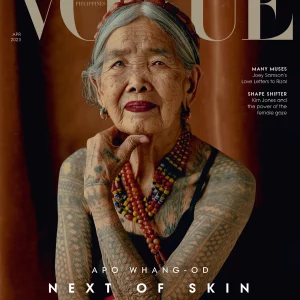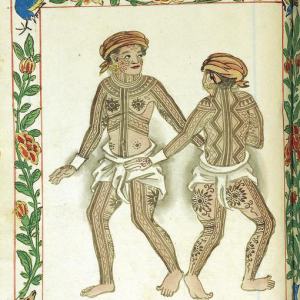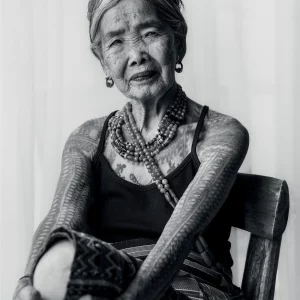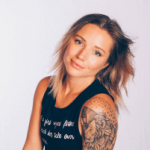Apo Whang-Od – Tattooing Legend And Vogue Cover Model
This April’s Vogue Philippines Beauty issue launched with a face that is familiar to anyone interested in tattooing as a cultural tradition and an art form.
Apo Whang-Od, the indigenous tattooing legend from the remote mountainous village of Buscalan in the Kalinga province of the Northern Philippines, is now Vogue’s oldest cover star ever at 106 years old. The title was previously held by Dame Judy Dench, who graced the cover of British Vogue in June 2020 at the age of 86.
Global tattooing sensation of the Kalinga
She may have become widely known as a result of the recent iconic fashion magazine cover, but the global world of tattooing has known about Whang-Od for a long time. Starting some 15 years ago, her reputation travelled beyond the borders of the Philippines, and several body art collectors have made long trips, especially to be tattooed by her.

Whang-Od began tattooing the traditional Kalinga style known as Batok when she was 16 years old – the only female to learn the tradition at that time. She is now referred to as the oldest mambabatok, and has inspired a whole new generation to learn the craft.
The skill is passed on through the descending bloodline (Whang-Od learned it from her father). Whang-Od never had any children of her own, but she has trained her grand-nieces who are carrying on the tradition in their home village. The oldest, Grace, has also travelled to France and had guest spots at various tattoo studios there.
Three dot sign-off
Whang-Od herself only performs a signatory three-dot pattern these days (representing herself and her two grand-nieces) as a sort of autograph for those who have been tattooed by her nieces but says she will keep on doing so as long as her eyes can see.
Batok uses traditional techniques where a thorn attached to a bamboo stick is dipped into soot and natural dye. It is then tapped into the skin with another length of wood, driving it down over a hundred times per minute.

It has been carried out on both sexes in the Philippines since the pre-colonial era but fell out of favour when much of the area converted to Christianity after the arrival of Spanish colonisers in the 16th century. Some groups, such as the Tagalog, had converted to Islam and also lost the practice.
Rituals for warriors and beauty
For women, tattoos have been aesthetic enhancements, and beautification marks, whereas men have received them to mark some heroic feet in combat or social status.
Often, they consist of repeating geometric patterns and stylized images of various animals, plants, or even humans. They also feature celestial representations of the sun, moon and stars, along with other natural phenomena such as lightning, mountains or water.
Large chest tattoos on men, known as a bikking, identified them as head-hunting warriors. The pieces could take several days to complete, and the decorating of a warrior was done as a ritual that could span two or more years.

Whang-Od would reportedly travel around the neighbouring villages and areas but has tattooed more women than men, as headhunting was forbidden in the early 20th century by the Americans after they “acquired” the Philippines from Spain following the conclusion of the Spanish-American war in 1898.
In fact, in pre-colonial times, unmarked women were considered to be imperfect and undesirable. Of course, that all changed with the arrival of missionaries. Thankfully, the pendulum has swung again, and the tattooing history of the Butbut people is now being inked onto new skin and even celebrated on the cover of the world’s most prestigious fashion franchise.
